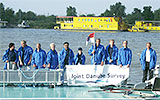JDS 1
Joint Danube Survey 2001
The ICPDR initiated the JDS 2001 to improve the validity and comparability of water quality data received from its regular monitoring programme (Trans-National Monitoring Network).
JDS 2001 stands for:
- 10 scientists of 7 countries
- 2 ships: "Argus", "Szechenyi”
- 2581 km river stretch
- 6 week journey
- 140 parameters analysed
- 40.000 results achieved
What are the JDS results?
Reliable and consolidated data of the water quality of the Danube and its major tributaries regarding biological parameters and chemical pollutants, aquatic flora and fauna and bacteriological indicators.
Issues of concern are the stretches with identified hot spots of pollutants listed in the EU Water Framework Directive as priority substances, the nutrient concentrations in the whole Danube with special attention to the middle part, and overall pollution by bacteria and heavy metals.
Biodiversity: The findings show the Danube to host a high degree of biodiversity. Over 1,000 aquatic species and higher-level organisms were identified, especially:
- 268 macrozoobenthos taxa (small animals living on the bottom sediment)
- 340 phytobenthos taxa (algae living on the bottom sediment)
- 49 macrophyte species (water plants and mosses)
- 261 phytoplankton taxa (algae drifting in the water)
- 120 zooplankton taxa (small animals drifting in the water).
Did you know?
The opening of the Main-Danube Canal in 1992 led to an increase of biodiversity, since it allowed river fauna to migrate between the Rhine and the Danube basins.
However, the consequences need to be monitored to be sure that it will not result in a deterioration of the typical Danubian species.
Organic pollution varied between "moderately" and "critically polluted". Many side arms and tributaries were more polluted than the main stream.
In certain stretches no macro-invertebrates were found at all – a clear indication of an even higher organic or toxic pollution.
Eutrophication: Particularly high concentrations of algal biomass were found in the Hungarian stretch downstream of Budapest, which indicates elevated nutrient concentrations.
Microbiological (bacterial) pollution is showing anthropogenic impacts possibly caused by insufficiently treated sewage (faecal pollution) and by impacts from farm land and pasture (manure). Faecal bacteria indicate also the potential presence of pathogenic bacteria, viruses and parasites endangering human health.
Specific heavy metal pollution hot-spots were detected (the Rusenski Lom, the Iskar and the Timok tributaries, Bulgaria).
Pollution from navigation, mainly oil was observed; the highest values of petroleum hydrocarbons in sediments and suspended solids were found in the Middle Danube reach.
From 23 pesticides under investigation only Atrazine and Desethylatrazine could be found along the Danube.
Significant concentrations of harmful chemical pollutants featuring on the EU Water Framework Directive List of Priority Pollutants, were found in bottom sediments as well as in suspended solids.
Lessons learned:
The results of the JDS have been taken as the basis for future activities of the ICPDR, specially focusing on:
- measures to decrease nutrient input from agriculture
- building of wastewater treament plants with nitrogen and phosphorus removal
- introduction of of phosphate-free detergents
- measures to decrease heavy metal pollution from the mining and metallurgy areas
- intensification of the cooperation with the Danube Navigation Commission on reducing oil pollution from shipping
- establishment of sediment quality targets
- improvement of the Danube Trans-National Monitoring Network (TNMN)

Institutional Background, Preparing the Joint Danube Survey, Findings of the Survey, Ecological Status of the Danube and its Major Tributaries, Chemical Status of the Danube and its Major Tributaries, Conclusions and Lessons learned
Gesetzlicher Rahmen, Vorbereitung der Donau-Untersuchung, Untersuchungsergebnisse, Der oeِkologische Zustand der Donau und ihrer Nebenflüsse, Der chemische Zustand der Donau und ihrer Nebenflüsse, Schlussfolgerungen

JOINT DANUBE SURVEY
Technical Report of the International Commission for
the Protection of the Danube River
September 2002
1.1 The Danube River Protection Convention - Its Role in the Protection of the Danube River 1.2 Assessment of Water Quality in the Danube River Basin - the Need for and the Aims of the Joint Danube Survey 2.1 Survey Plan 2.2 Preparatory Phase/Cruise Manual 2.3 JDS Core Team 2.4 JDS...
4.1 INTRODUCTION 4.2 MACROZOOBENTHOS
5.2.1 General Characteristics 5.2.2 Nutrients 5.2.3 Heavy Metals
JDS Technical Report
5.2.4.2.5 Petroleum Hydrocarbons in Mussels - 5.2.4.6 Other WFD Priority Pollutants

Joint Danube Survey
12 August - 20 September 2001
© 2002 ICPDR
Length: 19 min. 51 sec.
Disclaimer
The information contained in the ICPDR website is intended to enhance public access to information about the ICPDR and the Danube River. The information is correct to the best of the knowledge of the ICPDR Secretariat. If errors are brought to our attention we will try to correct them.
The ICPDR, expert group members, nor other parties involved in preparation of information contained on this website cannot, however, be held responsible for the correctness and validity of the data and information provided, nor accept responsibility or liability for damages or losses arising directly or indirectly from the use of the information conveyed therein.
Only those documents clearly marked ICPDR documents reflect the position of the ICPDR.
Any links to other websites are provided for your convenience only. The ICPDR does not accept any responsibility for the accuracy, availability, or appropriateness to the user's purposes, of any information or services on any other website.
When using the information and material provided on this website, credit should be given to the ICPDR.
